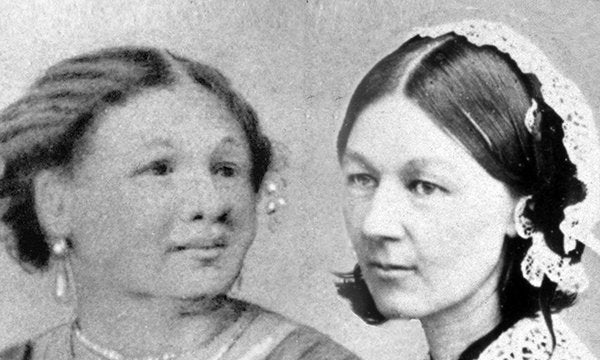History is full of echoes — names that reverberate down the corridors of time. Two such names, Florence Nightingale and Mary Seacole, stir the imagination like few others. Both women were healers in a time of unimaginable suffering. Both served in the Crimean War. And both, in their own ways, changed the face of nursing forever.
Yet they remain twin figures of contrast. One, the well-born lady in crisp uniform and lamp in hand, gliding down the halls of a military hospital with the confidence of state support. The other, a free-spirited Jamaican “doctress” in a bright headscarf, weaving through the smoke of the battlefield with a pouch full of remedies and no institutional backing to speak of.
They lived and worked in the same war. They are spoken of side by side. And so the question lingers: Did Florence Nightingale and Mary Seacole ever meet?
To answer that, we must first understand not only who these women were, but how the worlds they came from collided — or failed to.
Mary Seacole: The Other Nurse of the Crimea
Mary Seacole was born in 1805 in Kingston, Jamaica, the daughter of a Scottish soldier and a Creole healer. She inherited both lines of influence — military toughness and a sharp instinct for healing. Her mother ran a boarding house that doubled as a local clinic for British officers and their families, and it was there that Mary’s medical education began.
In her own words — from her 1857 autobiography Wonderful Adventures of Mrs. Seacole in Many Lands — she had “a longing to be of use,” and this longing took her far: to Panama, where she treated victims of cholera during an outbreak; to England, where she pitched her skills in a society unsure what to make of a Black Jamaican woman with medical knowledge; and finally, to the Crimea, where war had broken out and wounded soldiers were crying out for care.
Seacole applied to join the official nursing contingent being organized by Florence Nightingale. She was ignored. She applied again. And again. Rejected — not for lack of skill, but for lack of social fit. A Jamaican woman, calling herself a “doctress”? Not quite what the War Office had in mind.
So, she went anyway.
With her own savings and with supplies she could muster, Mary Seacole set sail for the front, arriving in Balaclava in 1855. There, she established the “British Hotel” — a combination mess hall, store, and convalescent center for British officers. She treated the wounded, fed the hungry, offered warmth and medicine, and when needed, rode out to the front lines to tend to the injured under fire.
She was not officially sanctioned. But she was there — and the soldiers never forgot her.
Florence Nightingale: The Lady with the Lamp
Florence Nightingale needs no introduction, but deserves one anyway. Born into a wealthy English family in 1820, she defied expectations from an early age. While her peers planned their social calendars, Florence pored over books on statistics, sanitation, and hospital reform. She saw in nursing not mere charity work, but a mission to bring discipline, order, and science to the chaos of suffering.
When the Crimean War broke out, the British public was appalled by reports of wounded soldiers lying in filth and squalor. In response, the government asked Nightingale to lead a team of nurses to Scutari, the military hospital in what is now Istanbul. She accepted — and transformed the place.
Under her leadership, mortality rates dropped dramatically. She instituted hygiene protocols, reorganized supply chains, and applied statistical methods to prove her case. Her lamp-lit night rounds became legend, immortalized in poetry and popular lore. By the time she returned home, she was a national icon.
Parallel Lives, Diverging Paths
So where, in all of this, did Mary Seacole and Florence Nightingale cross paths?
The answer lies not in collaboration, but in proximity — and perhaps in a tension of worlds.
According to Seacole’s own account, she did meet Nightingale — at least briefly. While in the Crimea, she visited Scutari, where Nightingale ruled over her nursing staff with formidable authority. Seacole recalls in her autobiography:
“I had opportunities of observing her closely; and although we were never intimate — for Miss Nightingale was somewhat reserved towards me — I could not help admiring her energy, her devotion, and her admirable self-control.”
It’s a respectful account — measured, but tinged with something else. There’s no animosity, but no warmth either. Certainly no partnership.
This short passage stands as the best firsthand evidence that they ever met. No official record corroborates a deep encounter. And Nightingale, for her part, made only sparse reference to Seacole in her many letters and diaries.
In a private note written years later, Nightingale would describe Seacole as a kind woman who ran a “canteen” and provided food and comfort to soldiers — but not, in her eyes, a “nurse.” It was a dismissive judgment, and it stung.
Why Didn’t They Work Together?
Historians today are less interested in imagining a grand rivalry between the two women than they are in asking: why didn’t they work together? The answer lies in class, race, and the very different spaces they inhabited — both physically and socially.
1. Different Theaters of War:
Nightingale was based at Scutari, overseeing a vast military hospital system supported by the state. Seacole was near the front lines in Balaclava, tending to soldiers in the field and running her independent establishment. Their roles barely intersected in practice.
2. Class and Racial Barriers:
Victorian Britain was not a place that welcomed a mixed-race woman into its upper echelons — especially not in medicine. Seacole, though well-spoken and confident, lacked the formal credentials and elite networks that Nightingale possessed. Her skin color alone was likely enough to see her excluded from the official nursing corps.
3. Philosophical Differences:
Nightingale was an administrator. She believed in systems, records, and strict cleanliness protocols. Seacole was improvisational, holistic, and deeply personal in her methods. Nightingale may have seen her as undisciplined. Seacole, meanwhile, never spoke against Nightingale — but one suspects she saw the rigidity of the official medical establishment as limiting.
Legacies: Remembering Both Women
After the war, Nightingale returned to England and launched a campaign that would reshape public health. She founded a nursing school, advised on hospital design, and used data to push policy changes that saved countless lives.
Mary Seacole, on the other hand, returned to London bankrupt and nearly forgotten. Her efforts had not been underwritten by the state. It was only through the support of grateful soldiers — and the publication of her autobiography — that she gained some measure of recognition. But by the end of the 19th century, her name had largely faded from the record.
It wasn’t until the late 20th and early 21st centuries that Seacole’s story was rediscovered, championed by scholars and campaigners eager to restore her place in history. Today, statues of both women stand in London — Nightingale outside the Ministry of Defence, Seacole outside St. Thomas’s Hospital, just across the Thames.
A Meeting in the Margins
So, did they meet?
Yes — in passing. A brief moment, a nod perhaps. No letters exchanged. No photos together. No shared projects. Not rivals, but not allies either. Each walked her own path in the Crimean mud.
But the real answer lies not in whether they shook hands or spoke words. It lies in what their lives say about the world they inhabited — and the world they helped to change.
Florence Nightingale made nursing a profession. She used her privilege to bend institutions toward reform.
Mary Seacole defied exclusion. She carved her way into the story with grit, generosity, and the sheer force of her will.
They were women of their time, and women ahead of it.
They met, yes — briefly. But history now invites us to see them side by side, not as competitors, but as co-architects of care in a time of war.
Further Reading:
-
Wonderful Adventures of Mrs. Seacole in Many Lands by Mary Seacole
-
Florence Nightingale: The Making of an Icon by Mark Bostridge
-
Mary Seacole: The Charismatic Black Nurse Who Became a Heroine of the Crimea by Jane Robinson
-
The Crimean War: A History by Orlando Figes

